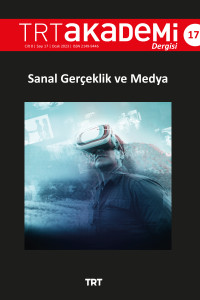Öz
Technology development affects all plastic arts fields; through this development, artists have new digital tools to express themselves. Artists and designers have used animation and graphic visualization methods and techniques for many years, especially in the cinema and game sectors. Although animation has been created with the principle of displaying images one after the other, while it was initially created with the direction of drawing each image separately using pen and paper, with the development of computer technologies, the possibilities of this field have begun to be used, so pixel, vector or 3D-based images has been able to produce with the help of digital tools in time. Especially after the 2000s, virtual reality technologies developed rapidly, which opened the doors of a brand new era in animation applications, with new hardware offered to designers, three-dimensional space included through this hardware, and digital tools provided by new software developed for this space. In this study, the innovations brought by the hardware and software offered by virtual reality technologies to the applicati- on of animation techniques are examined from a theoretical point of view through the Quill by Smoothstep software and the animations produced with this software. At the same time, the study was being revealed and discussed the effects of the subject in terms of art dialectic on a philosophical basis, so it was aimed to provide an academic contribution to the field in terms of conceptual knowledge, theory, and practice.
Anahtar Kelimeler
Virtual Reality Animation Digital Art Visual Design Digital Technology
Kaynakça
- Armstrong, Helen. (2007). Grafik Tasarım Kuramı. İstanbul: Espas Sanat Kuram Yayınları.
- Arnheim, Rudolf. (2015). Görsel Düşünme. İstanbul: Metis Yayınları
- Barnard, Malcolm. (2010). Sanat, Tasarım Ve Görsel Kültür. Ankara: Ütopya Yayınevi.
- Bayraktar, E., Kaleli, F. (2007). Sanal Gerçeklik ve Uygulama Alanları. Akademik Bilişim Dergisi, 2
- Berger, John. (2016). Görme Biçimleri. İstanbul: Metis Yayınları.
- Blocks. https://arvr.google.com/blocks/ (Erişim Tarihi: 15.11.2022).
- Burnett, Ron. (2012). İmgeler Nasıl Düşünür?. İstanbul: Metis Yayınları
- Freund, Gisele. (2016). Fotoğraf ve Toplum. İstanbul: Sel Yayıncılık.
- Guiraud, Pierre. (2016). Göstergebilim. Ankara: İmge Kitabevi.
- Gültekin, T. "Gerçeklik ve Sanı Yaklaşımı Üzerine Karşılaştırmalı Bir İnceleme: Denemeler Sergi Örneği". FLSF Felsefe ve Sosyal Bilimler Dergisi (2017): 277-29
- Gravity Sketch. https://www.gravitysketch.com/ (Erişim Tarihi: 12.11.2022).
- Heskett, John. (2002). Tasarım. Ankara: Dost Kitabevi.
- Jerald, Jason. (2016). The VR Book: Human-Centered Design for Virtual Reality. New York: ACM Books with Morgan & Claypool Publishers
- Kurbanoğlu, S, S. (1996). Sanal Gerçeklik Gerçek Mi, Değil Mi?. Türk Kütüphaneciliği Dergisi, 22.
- Leppert, Richard. (2002). Sanatta Anlamın Görüntüsü, İmgelerin Toplumsal İşlevi. İstanbul: Ayrıntı Yayınları.
- Lynton, Norbert. (2015). Modern Sanatın Öyküsü. İstanbul: Remzi Kitabevi.
- Masterpiece Studio. https://masterpiecestudio.com/ (Erişim Tarihi: 14.11.2022).
- Oculus. https://www.oculus.com/experiences/rift/1741124389277542/?locale=tr_TR (Erişim Tarihi: 09.11.2022).
- Quill. https://quill.art/ (Erişim Tarihi: 09.11.2022).
- Semantic Scholar Visual Design Methods for Virtual Reality. http://aperturesciencellc. com/vr/VisualDesignMethodsforVR_MikeAlger.pdf (Erişim Tarihi:03.11.2021).
- Sherman, William, R., Craig, Alan, B. (2019). Understanding Virtual Reality. Cambridge: Morgan Kaufmann Publishers
- TDK, Türk Dil Kurumu Sözlüğü. https://sozluk.gov.tr/ (Erişim Tarihi: 07.11.2022).
Öz
Anahtar Kelimeler
Sanal Gerçeklik Animasyon Dijital Sanat Görsel Tasarım Dijital Teknoloji Virtual Reality Animation Digital Art Visual Design Digital Technology
Kaynakça
- Armstrong, Helen. (2007). Grafik Tasarım Kuramı. İstanbul: Espas Sanat Kuram Yayınları.
- Arnheim, Rudolf. (2015). Görsel Düşünme. İstanbul: Metis Yayınları
- Barnard, Malcolm. (2010). Sanat, Tasarım Ve Görsel Kültür. Ankara: Ütopya Yayınevi.
- Bayraktar, E., Kaleli, F. (2007). Sanal Gerçeklik ve Uygulama Alanları. Akademik Bilişim Dergisi, 2
- Berger, John. (2016). Görme Biçimleri. İstanbul: Metis Yayınları.
- Blocks. https://arvr.google.com/blocks/ (Erişim Tarihi: 15.11.2022).
- Burnett, Ron. (2012). İmgeler Nasıl Düşünür?. İstanbul: Metis Yayınları
- Freund, Gisele. (2016). Fotoğraf ve Toplum. İstanbul: Sel Yayıncılık.
- Guiraud, Pierre. (2016). Göstergebilim. Ankara: İmge Kitabevi.
- Gültekin, T. "Gerçeklik ve Sanı Yaklaşımı Üzerine Karşılaştırmalı Bir İnceleme: Denemeler Sergi Örneği". FLSF Felsefe ve Sosyal Bilimler Dergisi (2017): 277-29
- Gravity Sketch. https://www.gravitysketch.com/ (Erişim Tarihi: 12.11.2022).
- Heskett, John. (2002). Tasarım. Ankara: Dost Kitabevi.
- Jerald, Jason. (2016). The VR Book: Human-Centered Design for Virtual Reality. New York: ACM Books with Morgan & Claypool Publishers
- Kurbanoğlu, S, S. (1996). Sanal Gerçeklik Gerçek Mi, Değil Mi?. Türk Kütüphaneciliği Dergisi, 22.
- Leppert, Richard. (2002). Sanatta Anlamın Görüntüsü, İmgelerin Toplumsal İşlevi. İstanbul: Ayrıntı Yayınları.
- Lynton, Norbert. (2015). Modern Sanatın Öyküsü. İstanbul: Remzi Kitabevi.
- Masterpiece Studio. https://masterpiecestudio.com/ (Erişim Tarihi: 14.11.2022).
- Oculus. https://www.oculus.com/experiences/rift/1741124389277542/?locale=tr_TR (Erişim Tarihi: 09.11.2022).
- Quill. https://quill.art/ (Erişim Tarihi: 09.11.2022).
- Semantic Scholar Visual Design Methods for Virtual Reality. http://aperturesciencellc. com/vr/VisualDesignMethodsforVR_MikeAlger.pdf (Erişim Tarihi:03.11.2021).
- Sherman, William, R., Craig, Alan, B. (2019). Understanding Virtual Reality. Cambridge: Morgan Kaufmann Publishers
- TDK, Türk Dil Kurumu Sözlüğü. https://sozluk.gov.tr/ (Erişim Tarihi: 07.11.2022).
Ayrıntılar
| Birincil Dil | Türkçe |
|---|---|
| Konular | İletişim ve Medya Çalışmaları |
| Bölüm | Makaleler |
| Yazarlar | |
| Yayımlanma Tarihi | 31 Ocak 2023 |
| Gönderilme Tarihi | 18 Kasım 2022 |
| Kabul Tarihi | 19 Aralık 2022 |
| Yayımlandığı Sayı | Yıl 2023 Cilt: 8 Sayı: 17 |
This work is licensed under Creative Commons Attribution-NonCommercial-NoDerivatives 4.0 International

